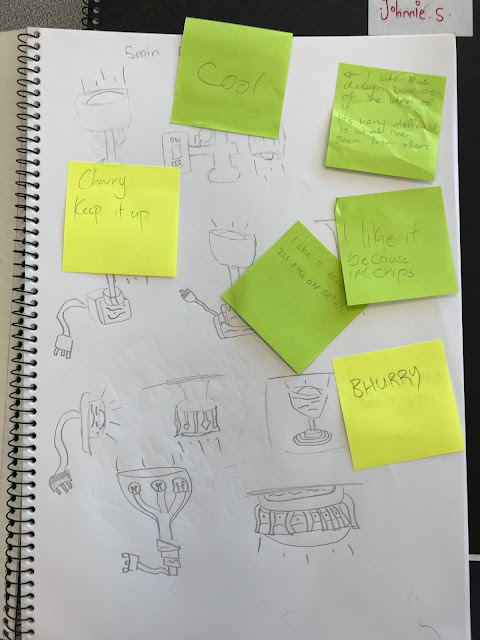I have a mixed NCEA Level 1 and Level 2 class. Within that class are students who have done Graphics before and students who haven't. This causes a lot of self doubt in a lot of the students who come in the room thinking they can't do it. They say to me "miss I can't draw", so they talk themselves out of achieving before they even start.
This shows even more now that we are past the research stage and are onto design ideas. They sit and stare at their sketchbooks for lesson after lesson, not feeling able to do anything. I try and sit with them and do some designing with them on loose pieces of paper so they can see me do it and copy. As soon as I walk away, they stop again, and obviously get off task really easily.
I always feel such a failure about this as I struggle to support them over these self made barriers in their mind.
Over the last two days I have tried something different with this class. We came back to school for term two this week and I saw them for the first time yesterday for a single period.
We played warm up games yesterday in the single period.
30 seconds to draw 5 things ... shapes, insects, animals, things that start with the letter A .....
They were slow and too fussy to start with. They soon loosened up and got into it, while not always hitting 5 for various reasons (putting too much detail in, thinking for too long ..)
As you can see, the quality of the drawing was not great but that was not the point. Quickly getting ideas down on paper was the point and beating that "blank page curse".
Today in the double period, we started with that for a few rounds to warm them up again and because not all the students were there yesterday.
Then they got their sketch books out and had to draw in there. They had to draw 10 different designs based on their project in 5 minutes.
They had to remember what they had learned in the 30 second warm ups - draw quickly, don't get lost in details, don't stress about the quality of the drawings.
They launched into this really well. They were nearly completely silent (very unusual with this lot ) and very focussed.
They then had to look at everyone else's work. they walked round the room looking at all the sketchbooks open on the desks. They had post it notes with them and they had to write one word feedback and stick it onto each other's books.
We equated that to getting a like on Facebook or a heart like on Instagram. That warm fuzzy you get when you see that what you have put online has been seen and liked.
Then they had to go round again and write a sticky saying what they liked and why.
After reading the warm fuzzies and the feedback from the rest of the class, they had to look at their own work and write a list of 5 things that they can do to improve one of their designs. I got them to write it as a list first so they could think about it separately to drawing.
Then they had to draw 3 design changes for that chosen design based on their list.
All of these activities had very limited time allowances (5 minutes, 2 minutes, 3 minutes .. ) and I was calling out the countdown as they went.
On these 3 design improvements they had to label what the improvements were that they had done.
They then had to look at each others work again and give marks out of 5 for the design changes work.
The last thing that they had to do was to look at all the work that had been done today and choose one from someone else's work. They then had to draw a design development for someone else and give it back to them personally so they knew who had drawn what.
They were very respectful when doing this and were careful to explain the changes they had done to someone's work and why when they gave it back.
At the end of the session today I asked them for some quick feedback by answering 4 questions for me.
What I noticed the most today was the level of engagement and being on task for the full double period and the amount of work produced in the time.
I used :-
- Timed activities for the whole lesson
- Small times on activities all the way through
- Peer to peer feedback and marking
- Giving warm fuzzies before the more detailed feedback so they felt good about their work
- Giving help and support to each other in the form of designing improvements for some one else.
- Not focussing on the quality or standard of their drawings but the ideas that they were coming up with.
Three students who absolutely hated today are my three perfectionists. I spoke to them after the lesson and told them I was proud of the way they approached the work and to let them know that I knew they were struggling. They tried really hard and did well.
My boys at the back who struggle with the whole designing process did well today. They produced more work today than they have since we started designing work and finished the research.
My next problem - How can I get this to influence the day to day designing that we have to do?
And - I was EXHAUSTED at the end of the double period as I was BAM BAM BAM though the whole thing.
















































